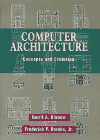If you have stories to share, or you've spotted some errors in my recollection of how things were back then, please write me at denichols@ridgefield-ct.com.
|
Buy IBM's 360 and Early 370 Systems by Emerson W. Pugh, Lyle R. Johnson, John H. Palmer |
 Buy Computer Architecture : Concepts and Evolution by Gerrit A. Blaauw, Frederick P.Brooks I've had the pleasure of working briefly with Dr. Fred Brooks, one of the architects of the S/360. Read this key book by one of the great men of computing! |
Back to Dave's Home Page |

 In 1966, the bank I worked at in Boston got one of the first IBM System
360's. We had a Model 30, a small one. I think it had 64K
of memory - this was the first system IBM made with the 8-bit
characters, and the word byte came into being. There were
several other innovations, too - our Mod 30 had disk storage
drives. We had 2311's, which were about 3' tall. The big
disks (about 18" in diameter, and 7-8" tall), which you removed
with a plastic cover that locked over
the disk, each stored an incredible 7.5 MILLION bytes! Another
advance over the 1401 was the Selectric typewriter console
(you can see it in the picture), so you could actually
type in number and letter
codes; you didn't need to enter them with toggle switches.
The 360 still used card readers, punches, tape drives,
and the same kind of chain/train printers that came with the
1401. But everything was faster, sleeker, compatible across the
whole 360 family - there were lots of different models - and,
incredibly, not much more expensive. No wonder the IBM S/360
quickly became the de facto standard of computing all
over the world.
In 1966, the bank I worked at in Boston got one of the first IBM System
360's. We had a Model 30, a small one. I think it had 64K
of memory - this was the first system IBM made with the 8-bit
characters, and the word byte came into being. There were
several other innovations, too - our Mod 30 had disk storage
drives. We had 2311's, which were about 3' tall. The big
disks (about 18" in diameter, and 7-8" tall), which you removed
with a plastic cover that locked over
the disk, each stored an incredible 7.5 MILLION bytes! Another
advance over the 1401 was the Selectric typewriter console
(you can see it in the picture), so you could actually
type in number and letter
codes; you didn't need to enter them with toggle switches.
The 360 still used card readers, punches, tape drives,
and the same kind of chain/train printers that came with the
1401. But everything was faster, sleeker, compatible across the
whole 360 family - there were lots of different models - and,
incredibly, not much more expensive. No wonder the IBM S/360
quickly became the de facto standard of computing all
over the world.